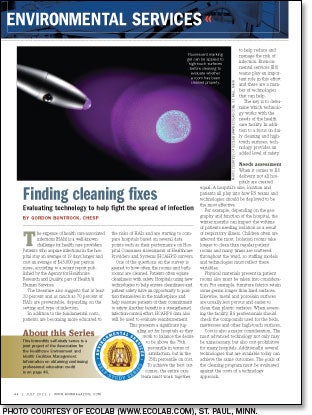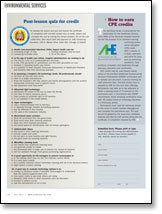Finding cleaning fixes
 The expense of health care-associated infections (HAIs) is a well-known challenge for health care providers. Patients who acquire infections in the hospital stay an average of 19 days longer and cost an average of $43,000 per person more, according to a recent report published by the Agency for Healthcare Research and Quality, part of Health & Human Services.
The expense of health care-associated infections (HAIs) is a well-known challenge for health care providers. Patients who acquire infections in the hospital stay an average of 19 days longer and cost an average of $43,000 per person more, according to a recent report published by the Agency for Healthcare Research and Quality, part of Health & Human Services.
The literature also suggests that at least 20 percent and as much as 70 percent of HAIs are preventable, depending on the setting and type of infection.
In addition to the fundamental costs, patients are becoming more educated to the risks of HAIs and are starting to compare hospitals based on several data points such as their performance on Hospital Consumer Assessment of Healthcare Providers and Systems (HCAHPS) surveys.
One of the questions on the survey is geared to how often the rooms and bathrooms are cleaned. Patients often equate cleanliness with safety. Hospitals using new technologies to help ensure cleanliness and patient safety have an opportunity to position themselves in the marketplace and help reassure patients of their commitment to safety. Another benefit is a strengthened infection-control effort. HCAHPS data also will be used to evaluate reimbursement.
This presents a significant juggling act for hospitals as they work to balance the desire to be above the 75th percentile in terms of satisfaction, but in the 25th percentile on cost. To achieve the best outcomes, the entire care team must work together to help reduce and manage the risk of infection. Environmental services (ES) teams play an important role in this effort and there are a number of technologies that can help.
The key is to determine which technology works with the needs of the health care facility. In addition to a focus on daily cleaning and high-touch surfaces, technology provides an added level of safety.
Needs assessment
When it comes to ES delivery, not all hospitals are created equal. A hospital's size, location and patients all play into how ES teams and technologies should be deployed to be the most effective.
For example, depending on the geography and function of the hospital, the winter months can impact the volume of patients needing isolation as a result of respiratory illness. Children often are affected the most. Isolation rooms take longer to clean than regular patient rooms and many times are scattered throughout the ward, so staffing models and technologies must reflect these variables.
Physical materials present in patient rooms also must be taken into consideration. For example, furniture fabrics retain some germs longer than hard surfaces. Likewise, metal and porcelain surfaces are usually less porous and easier to clean than plastic surfaces. When assessing the facility, ES professionals should check the compounds used for the beds, mattresses and other high-touch surfaces.
Cost is also a major consideration. The most advanced technology not only may be unnecessary, but also cost-prohibitive for many hospitals. Additionally, several technologies that are available today can achieve the same outcomes. The goals of the cleaning program must be evaluated against the costs of a technology approach.
Types of technology
Once a thorough assessment of a hospital's needs is completed, a multitude of technology options can be used on their own or combined with each other to help ES teams reduce infection risk. These include the following:
Ultraviolet (UV) lamp technology. This technology uses pulses of UV light to disinfect such surfaces as telephones, bed rails, tray tables, chairs and other high-touch surfaces. It is effective on norovirus, methicillin-resistant Staphylococcus aureus (MRSA), Clostridium difficile and a number of other pathogens. The length of time this process can take is relative to the room size and light-reflective surfaces. Some rooms could take as little as 10 minutes or as long as an hour. It is an extra layer of protection to support manual cleaning. The units range from $34,000 to $120,000. Patients and staff are not present when this is used.
Vapor technologies. These machines or aerosols use a misting type of fog that comprises chemicals including hydrogen peroxide and peroxyacetic acid to cover surfaces and kill bacteria. The process can take from 20 minutes to 270 minutes to complete and patients must be out of the room at the time of the procedure.
Electrolyzed water systems. These technologies, which produce hypochlorous acid, are now reaching the market and may hold promise. They are non-toxic cleaning and sanitizing solutions that are broad spectrum disinfectants, meaning that they kill pathogens like MRSA, Listeria and others. They are powerful degreasers, emulsifiers and surfactants that hold potential as a lower-cost alternative to traditional products.
Antimicrobial alloys. Certain metals, such as copper and silver, are non-absorbent hard surfaces that have antimicrobial properties. These metals can be used on high-touch surfaces such as light fixtures and door handles. Silver is also used in textiles such as cubical curtains. The cost varies depending on the size of the hospital and the quantities of material needed. As with vapor technologies and electrolyzed water systems, the use of a copper alloy surface is a supplement to and not a substitute for standard infection control practices.
Microfiber cleaning tools. Studies have indicated that the use of microfiber mops and towels versus those made from cotton or rayon shows a reduction of 99.84 percent of contaminants on stainless steel surfaces. Microfiber tools also can be processed after a single use, preventing the spread of infection that could occur through standard string mops and buckets that are used for multiple rooms.
Technology for inspection. A popular new inspection method includes using fluorescent markers to determine cleaning effectiveness. Following cleaning procedures, blacklights can be used in combination with a fluorescent marker or powder to determine the effectiveness in removing germs. Luminometers and adenosine triphosphate (ATP) testing is another method to determine cleaning quality following cleaning activities.
Adding value
ES managers should take the initiative to work with their hospital's infection prevention professionals to evaluate and present new technologies to the infection control team. Many times, hospitals become aware of technologies from the companies that make certain pieces of equipment and get their education from a single manufacturer's point of view.
ES professionals can add value to their roles on a hospital's infection control team by helping the team understand all of the technologies that can help reduce HAIs and then starting a dialogue about which technologies might be a good fit. This discussion could take place at a monthly infection prevention meeting, which is commonly held by most hospitals.
ES professionals should keep in mind that presenting these new technologies is introducing an expense to the hospital. Therefore, it's important that ES managers discuss technology options as cost-containment efforts. They should know the facts and offset the technology investment with the cost of treating HAIs.
Doing their homework up front will enable ES professionals to advocate for certain technology solutions. This includes conducting a literature review for technologies that might be considered in conjunction with the hospital's infection prevention professional. Once the facts are discovered, ES professionals should present the science so that other infection control committee members can understand them.
Taking the next step
Driving a review of technologies to help prevent HAIs is a process ES leaders can help manage for their health care organizations.
Pulling together the resources to present the options, whether from literature or by tapping into an outside organization that can help evaluate technologies, is a great way for ES managers to get started.
Taking the time to evaluate and understand a hospital's unique setting as well as the health care cost and patient satisfaction trends to which ES is linked will help ES professionals present a case that will command the attention of hospital administration. HFM
Gordon Buntrock, CHESP, is the environmental services operations support director for Aramark Healthcare. He may be contacted at buntrockgordon@aramark.com.
About this seriesThis bimonthly self-study series is a joint project of the Association for the Healthcare Environment and Health Facilities Management. Information on obtaining continuing professional education credit can be found here. |  |
| Click above image for quiz. |



